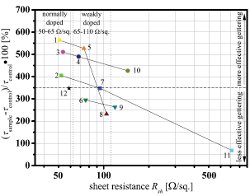By T. M. Pletzer, Project Manager, RWTH Aachen University, Institute of Semiconductor Electronics; H. Windgassen, RWTH Aachen University, Institute of Semiconductor Electronics; H. Kurz, RWTH Aachen University, Institute of Semiconductor Electronics
Phosphorus dopant pastes are an attractive alternative to the conventional phosphorus oxychloride (POCl3) dopant source for emitter processing in solar cells, as they allow the fabrication of selective emitters on an industrial scale. In this paper it is demonstrated that single-sided uniform screen-printed emitters, processed with phosphorus dopant pastes, can getter multicrystalline silicon (mc-Si) wafers more effectively than conventional double-sided uniform POCl3 emitters. This result is confirmed by minority carrier lifetime measurements with the quasi-stead-state photoconductance (QSSPC) method. Solar cells with selective emitters were processed using phosphorus dopant pastes on mc-Si wafers and were subsequently characterized. The current-voltage (I-V) results are improved compared to uniform POCl3 emitter solar cells and an increased internal quantum efficiency (IQE) for selective emitter solar cells is demonstrated.



